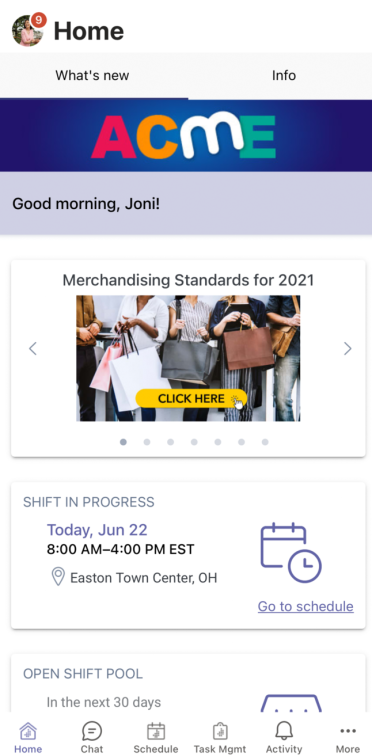
All the sessions from Transform 2021 are obtainable on-demand now. Watch now.
WorkJam, a platform that businesses such as Kroger, Shell, and Target use to engage with frontline workers, has raised $35 million in a round of funding from Silver Lake Waterman.
Founded out of Canada in 2014, WorkJam serves as a communication conduit for headquarters to liaise with these working out in the field, from overall health care specialists and manufacturing personnel to grocery delivery drivers and any person not tethered to a physical desk.
Modular
The WorkJam platform constitutes several “modules” that enterprises can choose and decide on from based on their desires, which includes managing shifts and tasks clocking in and out instruction surveying and polling messaging and more — all from a single app.
At its core, WorkJam is setting out to increase “productivity and employee retention,” WorkJam’s CEO Steven Kramer told VentureBeat. “WorkJam enables companies to use the labor they have more efficiently,” he stated. “When frontline employees feel more connected to and heard by their employer it fosters engagement. When employees feel like they have opportunities to find extra shifts, take training to increase their skill set and value, be recognized for good work — all of these things add up to a more engaged employee that is more motivated and satisfied with their work.”
For instance, with the WorkJam Task Management module, businesses can broadcast and assign each day tasks straight to frontline staff with the vital expertise for these tasks. And via its Open Shift Marketplace module, they can communicate all their obtainable shifts to their frontline workforce — this contains open shifts at nearby areas. “This enables powerful increases in labor utilization efficiencies,” Kramer added.
The Montréal-based organization also not too long ago launched WorkJam Everywhere, permitting businesses to integrate WorkJam’s several elements into third-party platforms via APIs. This signifies that businesses can plug an person WorkJam module — for instance, timesheets or scheduling — straight into Microsoft Teams.
This correctly signifies that WorkJam has decoupled WorkJam’s back-finish from its front-finish, in what WorkJam CEO Steven Kramer stated was akin to “omni-channel and headless commerce,” but for human capital.
“By embedding WorkJam functionality into existing systems, businesses get the operational benefits WorkJam customers have enjoyed for years with limited change in management,” Kramer stated. “Prior to developing WorkJam Everywhere, customers could only use WorkJam’s platform to deliver WorkJam’s functionality — now they have a choice as to how they want to deliver it.”

This level of flexibility signifies that worldwide businesses can deploy WorkJam in diverse approaches, based on the workflows of their regional offices. So one division could possibly use WorkJam inside Teams, though one more unit that does not use Teams can just use the WorkJam platform straight. Similarly, a organization could possibly want to embed WorkJam in other platforms such as Salesforce, SharePoint, Blue Yonder, or even their personal home-baked systems.
Working capital
There has been a flurry of activity across the workforce management sphere of late, with Workday acquiring Peakon for $700 million to capture true-time employee sentiment information and Skedulo securing $75 million to support businesses handle and analyze their deskless workforce.
WorkJam, for its portion, had previously raised $62 million, the bulk of which came by way of its series C round last April. With its most current $35 million money injection, the organization is properly-positioned to cater to the estimated 80% of workers — some 2.7 billion persons globally — who do not work from a desk.
It’s worth stressing right here that there is a clear distinction in between frontline workers and remote workers — WorkJam hasn’t pivoted or refocused its efforts to cater to the pandemic-driven distributed workforce. Remote workers are nonetheless desk-based, and they currently have a suite of tools at their disposal.
“We started the company with the idea of what it would look like if frontline employees had a digital workplace like desk workers do,” Kramer explained. “What productivity, employee engagement, retention, labor utilization and process innovation would be possible with this? Our number one focus has been to enable enterprises to orchestrate frontline operations. In fact, when desk workers went remote, the lack of tools for deskless workers went on full display. There is a technology gap in most businesses that ends up making operations fall apart at the location level of a business — WorkJam solves this.”



/cdn.vox-cdn.com/uploads/chorus_asset/file/23954050/STK427_Getty_Headphones.jpg)


/cdn.vox-cdn.com/uploads/chorus_asset/file/23986615/acastro_STK097_01.jpg)